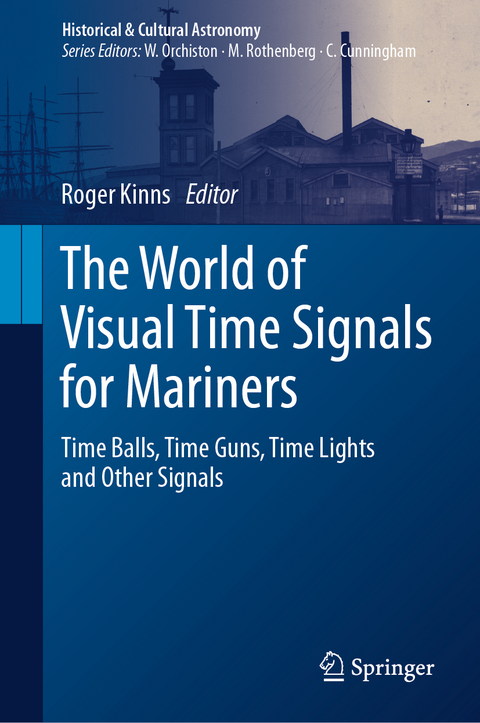
The World of Visual Time Signals for Mariners
Springer International Publishing (Verlag)
978-3-031-57333-0 (ISBN)
- Noch nicht erschienen - erscheint am 10.12.2024
- Versandkostenfrei
- Auch auf Rechnung
- Artikel merken
This book describes the worldwide evolution of land-based visual time signals that were used by mariners in the nineteenth and twentieth centuries for accurate navigation at sea. They followed development of chronometers which were carried in ships to show mean time at Greenwich, the chosen prime meridian. Greenwich time could be compared with local astronomical time to determine longitude, but chronometers were mechanical devices that had to be checked for accuracy. Land-based signals that were regulated by astronomical observations evolved from the ideas in 1818 of Robert Wauchope, a British naval officer who served at the Cape of Good Hope. He inspired introduction of time balls, specifically the time ball at Greenwich in 1833 which set the standard for subsequent installations and is still in operation today. The main emphasis is on the external appearance of time signals at different locations around the world and how they were used by mariners for rating chronometers. Time balls and guns also became popular signals for public use and workplace control but then had social and political implications.
Dr Roger Kinns was born in Winchester, England in 1944. He read Mechanical Sciences as an undergraduate at Gonville and Caius College, Cambridge and then took an MASc degree in control engineering at the University of Waterloo in Ontario, Canada, before returning to Cambridge to complete a PhD on unsteady aerodynamics.
Roger was Maudslay Research Fellow of Pembroke College, Cambridge, from 1971 to 1975. He then joined YARD Ltd in Glasgow, Scotland to lead development and application of techniques for the acoustic design of ships and submarines. He has worked as an independent consultant since 1999. Until 2019 he was a Senior Visiting Research Fellow in the School of Mechanical and Manufacturing Engineering at the University of New South Wales in Sydney, Australia. He has helped to supervise research students in acoustics at the Universities of Cambridge, Newcastle and New South Wales and has published widely in journals ranging from the Journal of Sound and Vibration to the Journal of Astronomical History and Heritage. The Maudslay connection led to an enduring fascination with the history of engineering and particularly time signals worldwide.
Presently, Roger is Treasurer of the Maudslay Society and Maudslay Scholarship Foundation, and Chairman of the Younger (Benmore) Trust that has supported development of Benmore Botanic Garden since 1928. He is also a member of the Newcomen Society, the Society for the History of Astronomy, the Royal Northern and Clyde Yacht Club, the Tasmanian Philatelic Society and the Incorporation of Gardeners of Glasgow, having been Deacon in 2009-2010. He is co-owner of Thalia, a racing keelboat built in 1924. It shares its name with the RN frigate which Wauchope commanded in the 1830s. Roger has lived in Clynder, near Helensburgh, Scotland since 1975.
Part I: Development of Visual Time Signals.- Chapter 1: Foundations.- Chapter 2: Determination of Longitude and Chronometer Rating.- Chapter 3: Ideas for Visual Time Signals.- Chapter 4: The Greenwich Time Ball and its Evolution.- Chapter 5: Time Ball Supply by Maudslay, Sons & Field after 1852.- Chapter 6: Admiralty Lists of Visual Time Signals after 1880.- Chapter 7: British and Irish Time Signals for General Use.- Part II: Visual Time Signals for Mariners around the World.- Chapter 8: Introduction to Part II.- Chapter 9: Worldwide Evolution of Visual Time Signals after 1880.- Chapter 10: British Isles.- Chapter 11: France, Spain, Portugal and Gibraltar.- Chapter 12: Germany and Danzig.- Chapter 13: The Netherlands, Belgium and Scandinavia.- Chapter 14: Russia, Finland and Latvia.- Chapter 15: The Mediterranean.- Chapter 16: South Africa.- Chapter 17: West and East Africa, and Yemen.- Chapter 18: Mauritius.- Chapter 19: Indian Subcontinent.- Chapter 20: Southeast Asia.- Chapter 21: China, Japan and Korea.- Chapter 22: Australia.- Chapter 23: New Zealand.- Chapter 24: Canada, Newfoundland and Bermuda.- Chapter 25: The United States of America, including Hawaii.- Chapter 26: Central America, The West Indies and South America.- Chapter 27: Atlantic Islands.- Chapter 28: Concluding Remarks.
| Erscheinungsdatum | 20.11.2024 |
|---|---|
| Reihe/Serie | Historical & Cultural Astronomy |
| Zusatzinfo | X, 471 p. 252 illus., 186 illus. in color. |
| Verlagsort | Cham |
| Sprache | englisch |
| Maße | 155 x 235 mm |
| Themenwelt | Naturwissenschaften ► Physik / Astronomie ► Allgemeines / Lexika |
| Naturwissenschaften ► Physik / Astronomie ► Astronomie / Astrophysik | |
| Sozialwissenschaften | |
| Schlagworte | Astronomical History of Time Guns and Time Balls • Early Methods for Calculating Lunar Distances • Early Methods of Measuring Astronomical Time • History of Chronometers • Time Signals for Mariners |
| ISBN-10 | 3-031-57333-1 / 3031573331 |
| ISBN-13 | 978-3-031-57333-0 / 9783031573330 |
| Zustand | Neuware |
| Haben Sie eine Frage zum Produkt? |
aus dem Bereich


